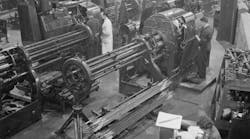The North American manufacturing boom has a cost. According to research from U.S. brokerage house Morgan Stanley, most of the industrial machinery in use is at least 10 years old. Not since 1938 have North American factories worked with such out-of-date equipment.
Upgrades may be slow in coming, especially for those producers still recovering from the devastating impact of years of offshoring. Overall, U.S. orders for tooling and related factory equipment fell 2.7% in the first half of the year, The Wall Street Journal reported recently.
North American producers are being asked to do more in the meantime. According to the latest data from the RBC Canadian Manufacturing Purchasing Managers’ Index, manufacturing activity rose to 54.8 last month—up from 53.3 in July and the highest total since November 2013. (A score of 50 or above signals growth.) In the U.S., The Institute of Supply Management’s index of manufacturing activity rose to 59.0 in August, up from 57.1 the month prior and another three-year high.
Once you fully understand the impact of the old equipment on your floor, run some calculations. How much more could you get out of each machine with a workaround? What would that amount to in extra revenue?
We have no way of knowing when capital spending budgets will get a boost, leaving floor managers with the uncomfortable task of making do with aging equipment. Here are five tips for getting by while still meeting demand:
1. Identify trouble spots. Not all equipment is created equal. Take an assessment of the factory floor to find machinery that’s either close to failure or not producing as expected. How far below standard is each piece of equipment? The factory as a whole? Know the specific cost of not upgrading.
2. Estimate your savings. Once you fully understand the impact of the old equipment on your floor, run some calculations. How much more could you get out of each machine with a workaround? What would that amount to in extra revenue? Figure out whether a fix would pay enough to justify the effort required, or whether you’d be better off writing a check for new machinery.
3. Find your MacGyvers. And if a life-extending workaround makes sense? Take a survey of your workforce. Specialists who’ve been handling specific types of equipment for years may have creative ideas to boost efficiency. Give them the authority to experiment.
4. Set bounties for difficult challenges. Track each experiment to get a sense of what may be possible. Then, set bigger targets and attach a bounty to encourage friendly competition among experts. Publicly acknowledge and celebrate each new win, and then record the gains in a log book. You’ll want to that data when it comes time to argue for new equipment and perks for the workers whose initiative and ingenuity helped solve a difficult problem.
5. Raise the stakes. Business is a team sport, and everyone—from the bench to the starting lineup—plays a role. Account for this by creating factorywide incentives for when targets are met. That way, your everyday workers will be more likely to give specialists the extra time needed to work on and complete special projects.
Business is a team sport, and everyone—from the bench to the starting lineup—plays a role. Account for this by creating factorywide incentives for when targets are met.
No factory worker wants to suffer at the hands of aging equipment. So make the effort worthwhile. Identify trouble spots. Calculate your savings and then seek out the “MacGyvers” capable of finding creative fixes. Set specific bounties for success, and let everyone share in the benefits.
Productivity may be tougher to come by in an aging factory, but it needn’t be a permanent bottleneck. Give your workers proper incentive, and they’ll find the workarounds.
John Mills is executive vice president of Business Development at Rideau Recognition Solutions, a global leader in employee rewards and recognition programs designed to motivate and increase engagement and productivity across the workforce.




